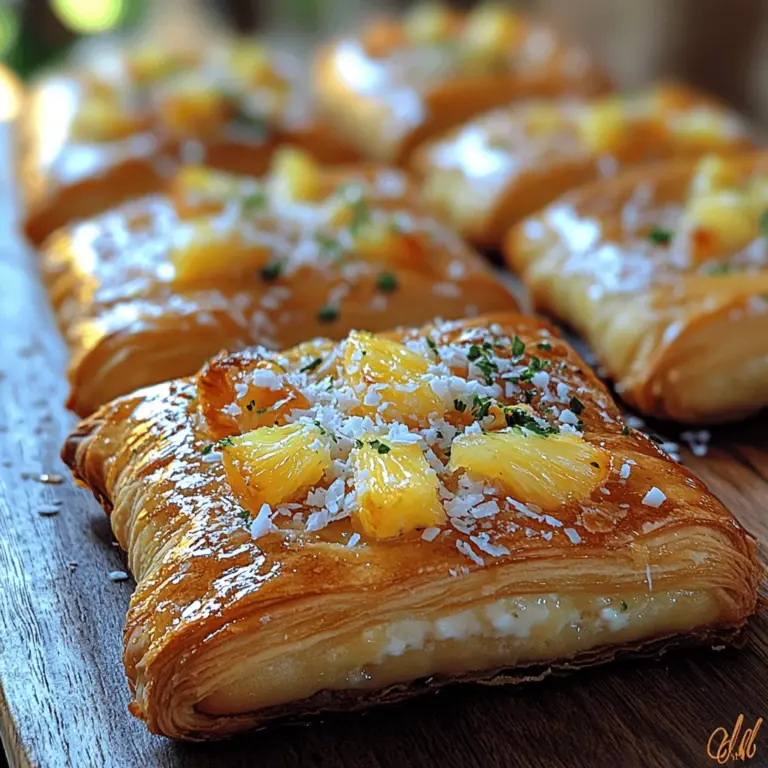Imagine biting into a flaky pastry that is both light and rich, with a creamy cheesecake filling that exudes tropical flavors. The Tropical Paradise Cheesecake Danish is not just a treat for the taste buds; it’s an experience that transports you to sun-kissed beaches and lush landscapes. This delightful dessert combines the classic elements of Danish pastry with a luscious cheesecake filling, accented by the vibrant tastes of crushed pineapple, lime zest, and sweetened shredded coconut.
Perfect for brunches, parties, or simply as a sweet indulgence at any time of the day, this recipe brings together the essence of tropical islands, making it a stunning centerpiece for gatherings. Not only does it satisfy your sweet tooth, but it also impresses guests with its intricate layers and bold flavors. In this article, we will take you through the history of Danish pastry, delve into the essential ingredients that make this cheesecake Danish truly remarkable, and provide a step-by-step guide that ensures your baking success.
Understanding Danish Pastry
Definition and Origin of Danish Pastry
Danish pastry, often simply referred to as “Danish,” has its roots in the 19th century. While it is commonly associated with Denmark, its origins are a blend of influences from various European baking traditions. The story goes that Austrian bakers introduced the concept of laminated dough to Denmark when they went on strike, leading Danish bakers to adopt and adapt the technique. The result was a light, flaky pastry that became a staple in Danish bakeries.
Danish pastry is known for its unique method of preparation, which involves layering dough and butter to create a rich, flaky texture. This technique, often called lamination, is key to achieving the characteristic layers that make Danish pastries so delightful. The dough is rolled out, folded, and chilled multiple times, resulting in a pastry that is both crispy on the outside and tender on the inside.
Unique Qualities of Danish Pastry
What sets Danish pastry apart from other pastries is its versatility. It can be shaped into various forms, from twisted braids to spirals, and can be filled with a wide array of ingredients, including fruit, cheese, and custards. The combination of buttery flavor, delicate texture, and the ability to hold fillings makes Danish an ideal canvas for creative recipes like the Tropical Paradise Cheesecake Danish.
In addition, Danish pastries can be enjoyed at any time of day. They can be served as a breakfast item, a snack, or a dessert, making them a beloved choice across cultures. Whether enjoyed with a cup of coffee or as a sweet ending to a meal, Danish pastries have earned their place in the hearts of many.
Common Uses of Danish Pastry in Various Cuisines
The versatility of Danish pastry allows it to be incorporated into various culinary contexts. In Denmark, it is often enjoyed with coffee or tea, served plain or adorned with icing. In other regions, such as the United States, Danish pastries have evolved into a popular breakfast item, often filled with cream cheese, fruit preserves, or custard.
Furthermore, the customizable nature of Danish pastries makes them a favorite at celebrations and special occasions. Bakeries and home bakers alike embrace this pastry for holiday gatherings, brunches, and bake sales, showcasing their creativity through different fillings and toppings. With its universal appeal, the Tropical Paradise Cheesecake Danish is the perfect representation of how this delightful pastry can be reinvented to create something extraordinary.
Ingredients Breakdown
To truly appreciate and master the Tropical Paradise Cheesecake Danish, it is crucial to understand the role of each ingredient in the recipe. Here’s a detailed examination of the essential components:
All-Purpose Flour
All-purpose flour is the backbone of the Danish dough, providing the necessary structure and texture. Its moderate protein content allows for the perfect balance between tenderness and strength, ensuring that the pastry holds its shape while still being flaky. The flour is a crucial element in the lamination process, helping to create the layers that are characteristic of Danish pastries.
Granulated Sugar
Sugar not only sweetens the dough and filling but also enhances the overall flavor profile of the Danish. In the pastry dough, it aids in browning and contributes to a tender texture. In the cheesecake filling, granulated sugar balances the richness of the cream cheese and sour cream, creating a harmonious blend of flavors.
Salt and Instant Yeast
Salt is essential for enhancing the flavor of the dough, while instant yeast is key to achieving the desired rise. The yeast fermentation process creates air pockets within the dough, resulting in a light and airy texture. Together, these ingredients work to elevate the overall taste and texture of the Danish pastry.
Unsalted Butter
Butter is a critical component in achieving the flaky layers of Danish pastry. Using unsalted butter allows for greater control over the salt content in the recipe. When incorporated into the dough, the butter’s fat creates pockets that separate the layers during baking, resulting in the signature flaky texture. The rich flavor of butter also contributes to the overall decadence of the pastry.
Cream Cheese and Sour Cream
The creamy filling of the Tropical Paradise Cheesecake Danish is made rich and decadent with the combination of cream cheese and sour cream. Cream cheese provides a smooth texture and tangy flavor, while sour cream adds moisture and a slight tartness that balances the sweetness of the filling. Together, they create a luscious filling that perfectly complements the flaky pastry.
Crushed Pineapple and Lime Zest
To achieve the tropical essence of this cheesecake Danish, crushed pineapple is a star ingredient. It adds natural sweetness and a burst of flavor that transports you to a tropical paradise with every bite. Lime zest introduces a refreshing citrus note, brightening the filling and enhancing the overall flavor profile.
Sweetened Shredded Coconut
Sweetened shredded coconut adds both texture and flavor to the topping of the Tropical Paradise Cheesecake Danish. It provides a delightful chewiness that contrasts beautifully with the creamy filling and flaky pastry. The coconut also reinforces the tropical theme, making each bite feel like a mini vacation.
Step-by-Step Guide to Making Tropical Paradise Cheesecake Danish
Now that we have a comprehensive understanding of the ingredients, let’s dive into the step-by-step process of creating this delectable Tropical Paradise Cheesecake Danish. This guide will ensure clarity and ease of understanding, making it accessible for bakers of all skill levels.
Crafting the Danish Dough
The first step in making your Tropical Paradise Cheesecake Danish is preparing the Danish dough. Start by combining the dry ingredients—All-purpose flour, granulated sugar, salt, and instant yeast—in a large mixing bowl. Whisk these ingredients together until they are well blended. This combination will form the foundation of your pastry.
Next, cut in chilled unsalted butter using a pastry cutter or your fingertips, until the mixture resembles coarse crumbs. This step is crucial, as it will help create the flaky layers of the pastry. Be careful not to overwork the dough; you want to maintain small bits of butter throughout for optimal flakiness.
Once the butter is incorporated, gradually add cold water to the mixture, stirring until a dough begins to form. The goal is to create a cohesive yet slightly tacky dough that will hold together without being overly sticky.
Chilling the Dough
After forming the dough, it is important to chill it for at least 30 minutes. Chilling the dough not only makes it easier to handle but also allows the gluten to relax, resulting in a more tender pastry. Wrap the dough in plastic wrap and refrigerate it while you prepare the cheesecake filling.
Preparing the Cheesecake Filling
While the dough is chilling, you can focus on creating the delicious cheesecake filling. In a mixing bowl, combine softened cream cheese and sour cream. Beat the mixture until smooth and creamy, ensuring there are no lumps. Gradually add granulated sugar and mix until fully incorporated, followed by the crushed pineapple and lime zest. The result should be a rich, creamy filling with a delightful tropical flavor.
Rolling Out the Dough
Once the dough has chilled, it’s time to roll it out. On a lightly floured surface, roll the dough into a rectangle, aiming for about 1/4 inch thickness. Take your time to ensure even thickness, as this will contribute to the final texture of the Danish.
After rolling out the dough, use a sharp knife or pizza cutter to cut the dough into squares or rectangles, depending on your preferred shape. Each piece will cradle a portion of the cheesecake filling.
With the dough and filling prepared, you are well on your way to creating the Tropical Paradise Cheesecake Danish. In the next part of this article, we will continue with the final assembly and baking steps, ensuring that your pastry turns out perfectly golden and delicious. Stay tuned for the delightful conclusion to this tropical baking adventure!

Shaping the Danish
Shaping the Danish is a crucial step that transforms your dough into a beautiful pastry ready for filling. Start by rolling out your chilled dough on a lightly floured surface. Aim for a rectangle about ¼ inch thick. This thickness is important; too thin, and the Danish will be tough, while too thick can make it doughy.
Once you have your rectangle, use a sharp knife or a pizza cutter to cut the dough into smaller squares, typically about 4 to 5 inches in size. For each square, make a shallow cut into each corner, stopping about 1 inch from the center. This will create flaps that you can fold over the filling later.
Cutting and Preparing the Dough for Filling
Preparation is key when it comes to filling the Danish. After cutting the dough into squares and making corner cuts, gently stretch each square to create a little more room for the filling. You want to ensure that the dough can accommodate a generous portion of your cheesecake filling without tearing.
Lightly flour your work surface as you handle the dough to prevent sticking. If you find that the dough is becoming too warm and soft, place it back in the refrigerator for a few minutes until it firms up again. This will make it easier to handle.
Filling the Danish
Now comes the exciting part—filling your Danish with the luscious Tropical Paradise cheesecake mixture. Using a spoon or a piping bag, place about 1-2 tablespoons of the cheesecake filling in the center of each square. Be careful not to overfill, as this can cause the filling to ooze out during baking.
Once filled, gently fold each corner of the square over the filling, pinching the edges together to seal. If you’re having trouble sealing, you can use a little water to moisten the edges, helping them stick together better. Alternatively, you can leave the filling exposed in the center for a more rustic look, which is just as delightful.
Tips for Portioning the Filling and Sealing the Dough
When portioning the filling, consistency is key. Use a measuring spoon to ensure that each Danish receives an equal amount of filling. This not only helps with baking time but also ensures that everyone gets the same delicious experience.
To seal the dough properly, press down firmly on the edges after folding them over the filling. A fork can help create a decorative edge while also ensuring a tight seal. This prevents any filling from leaking out during baking and can also add a charming touch to your pastries.
Adding the Coconut Topping
The final touch to your Tropical Paradise Cheesecake Danish is the coconut topping. After sealing your Danishes, sprinkle a generous amount of shredded coconut on top of each one. This not only adds a delightful crunch but also integrates beautifully with the tropical theme of the pastry.
How the Coconut Enhances the Overall Flavor Profile
Coconut is a quintessential tropical ingredient, and its addition to the Danish accentuates the overall flavor profile. The subtle sweetness and nutty flavor of the coconut complement the creamy cheesecake filling and the tartness of the pineapple. When toasted, the coconut becomes even more fragrant, adding depth to each bite and enhancing the experience of a tropical paradise.
Applying the Egg Wash
To achieve that beautiful golden, glossy finish that makes pastries irresistible, an egg wash is essential. Beat one egg with a tablespoon of water or milk, and using a pastry brush, gently brush the mixture over the tops of your Danishes. This step not only adds color but also helps the coconut adhere to the dough.
Techniques for Achieving a Golden, Glossy Finish
When applying the egg wash, be careful not to let it pool in the center of the pastry, as this can create a soggy texture. Instead, focus on the edges and the tops. For an extra touch, you can sprinkle a little extra sugar over the egg wash before baking, which will caramelize and create a lovely sweet crust.
Baking to Perfection
Preheat your oven to 375°F (190°C) and line a baking sheet with parchment paper. Once your Danishes are ready, place them on the baking sheet, giving each one enough space to rise. Bake for 20-25 minutes or until they are golden brown and puffed.
Signs to Look for to Ensure the Danish is Perfectly Baked
Keep an eye on your pastries as they bake. They should be puffed up and have a rich golden color. The coconut topping should be lightly toasted, adding to the visual appeal. To check if they are done, gently tap the bottom of one Danish; it should sound hollow. If they are still doughy or pale, give them a few more minutes.
Cooling and Serving Suggestions
Once your Tropical Paradise Cheesecake Danishes are baked to perfection, remove them from the oven and allow them to cool on a wire rack. This prevents steam from building up underneath, which can make the bottoms soggy.
When it comes to serving, these Danishes are best enjoyed warm, but they can also be served at room temperature. They make a fantastic breakfast treat or a delightful dessert. For an added touch, consider drizzling a little lime glaze over the top or serving them with a dollop of whipped cream.
Flavor Profile and Texture
The Tropical Paradise Cheesecake Danish is an indulgent experience for the senses. The contrast between the flaky, buttery pastry and the creamy, rich filling creates a delightful texture that is both satisfying and light. The balance of sweetness from the cheesecake filling is perfectly complemented by the tangy pineapple and a hint of lime, creating a harmonious blend of flavors.
The coconut topping plays a critical role in enhancing the overall experience. Its crunchy texture contrasts with the smooth filling, while its sweet, nutty flavor ties all the elements together, ensuring each bite is a celebration of tropical goodness.
Cultural Significance of Tropical Flavors
Tropical flavors hold a special place in many cultures, often associated with warmth, sunshine, and vibrant landscapes. Ingredients like pineapple, coconut, and lime are staples in tropical regions, frequently featured in various cuisines. This Tropical Paradise Cheesecake Danish captures the essence of these flavors, merging them into a delightful pastry that transports you to a sunny beach with every bite.
The influence of tropical ingredients can be seen in many desserts worldwide—from the popular piña colada to tropical fruit tarts. This recipe beautifully highlights how these flavors can be incorporated into a classic European pastry, creating a fusion that appeals to a broad audience.
Variations and Customizations
While the Tropical Paradise Cheesecake Danish is a delightful treat as-is, there are numerous variations and customizations to suit different tastes and dietary needs. For those looking to mix things up, consider experimenting with alternative fruits for the filling, such as mango or passion fruit, which can add new dimensions of flavor.
For individuals with gluten sensitivities, a gluten-free pastry dough can be made using almond flour or a gluten-free all-purpose mix, ensuring that everyone can enjoy this treat. Additionally, for those following a vegan lifestyle, substitutions can be made for the cheesecake filling using cashews, coconut cream, or silken tofu to create a rich, creamy texture without dairy.
Conclusion
Making and sharing the Tropical Paradise Cheesecake Danish is a joyful experience that brings together a unique blend of flavors and textures. The versatility of this pastry allows it to shine in various settings, be it a casual brunch, a festive gathering, or a simple treat for yourself. Each bite transports you to a tropical paradise, making it a delightful escape from the ordinary.
Encouraging readers to try this recipe means inviting them to indulge in a culinary adventure that combines the richness of cheesecake with the lightness of a Danish pastry, enhanced by the tropical flavors that evoke sunny memories. So roll up your sleeves, gather your ingredients, and embark on this delicious journey to create your own Tropical Paradise Cheesecake Danish. Experience the wonderful flavors and textures for yourself, and share this delightful treat with friends and family for a truly memorable occasion.

